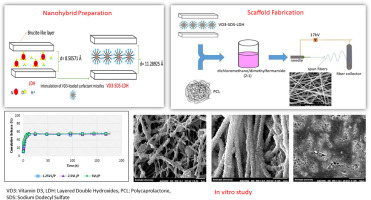当前位置:
X-MOL 学术
›
Appl. Clay. Sci.
›
论文详情
Our official English website, www.x-mol.net, welcomes your
feedback! (Note: you will need to create a separate account there.)
Bone tissue engineering electrospun scaffolds based on layered double hydroxides with the ability to release vitamin D3: Fabrication, characterization and in vitro study
Applied Clay Science ( IF 5.3 ) Pub Date : 2020-02-01 , DOI: 10.1016/j.clay.2019.105434 Ghazal Belgheisi , Masoumeh Haghbin Nazarpak , Mehran Solati Hashjin
Applied Clay Science ( IF 5.3 ) Pub Date : 2020-02-01 , DOI: 10.1016/j.clay.2019.105434 Ghazal Belgheisi , Masoumeh Haghbin Nazarpak , Mehran Solati Hashjin

|
Abstract Bone tissue engineered scaffolds can improve and accelerate the tissue regeneration alongside controlled release of drugs and signaling molecules while providing a suitable condition for cell adhesion and, proliferation. The current study involves the fabrication of Poly (ɛ-caprolactone) (PCL) electrospun scaffolds enriched with vitamin D3 (VD3)-loaded layered double hydroxides (LDHs) nanohybrid, in different concentrations. Characterizations confirmed successful synthesis of LDH and formation of crystalline planes and intercalation of VD3 in LDH with 65% encapsulation efficiency. Addition of low concentrations of LDHs nanohybrid to PCL scaffold led to a decrease in the fiber diameter; however, an increase in the surface roughness was observed at higher concentrations. Mechanical properties and porosity of the scaffolds were also evaluated and the results showed a decrease in elongation modulus in nanohybrid enriched scaffolds and no significant differences in porosity percentage was observed. Studies on bioactivity of scaffolds subjected to simulated body fluid (10 X SBF) indicated that the VD3 encouraged the formation of apatite-like crystals in vitro. Furthermore, the degradation rate of scaffolds increased due to the addition of nanohybrid. The cumulative release of VD3 showed the same pattern for all scaffolds through the diffusion as the main controlling mechanism of release. In vitro biological responses of the scaffolds were studied using MG-63 cell lines culture. The results indicated that nanohybrid containing scaffolds could highly support cell adhesion and proliferation. Likewise, alkaline phosphatase activity as an indicator of osteoconductivity for scaffolds showed no significant differences between nanohybrid containing and pure PCL scaffolds (p > .05). The results confirmed the potential of VD3-loaded LDH/PCL electrospun scaffolds for bone tissue engineering.
中文翻译:

基于具有释放维生素 D3 能力的层状双氢氧化物的骨组织工程电纺支架:制造、表征和体外研究
摘要 骨组织工程支架可以改善和加速组织再生,同时控制释放药物和信号分子,同时为细胞粘附和增殖提供合适的条件。目前的研究涉及制备富含不同浓度维生素 D3 (VD3) 层状双氢氧化物 (LDH) 纳米杂化物的聚 (ɛ-己内酯) (PCL) 电纺支架。表征证实了 LDH 的成功合成和结晶平面的形成以及 VD3 在 LDH 中的嵌入,封装效率为 65%。在 PCL 支架中加入低浓度的 LDHs 纳米杂化物导致纤维直径减小;然而,在较高浓度下观察到表面粗糙度增加。还评估了支架的机械性能和孔隙率,结果显示富含纳米复合材料的支架的伸长率模量降低,并且没有观察到孔隙率的显着差异。对经受模拟体液 (10 X SBF) 的支架生物活性的研究表明,VD3 促进了体外磷灰石样晶体的形成。此外,由于添加了纳米杂化物,支架的降解率增加。VD3 的累积释放通过扩散作为主要的释放控制机制对所有支架显示出相同的模式。使用 MG-63 细胞系培养物研究支架的体外生物学反应。结果表明,含有支架的纳米杂化物可以高度支持细胞粘附和增殖。同样地,碱性磷酸酶活性作为支架骨传导性的指标显示含有纳米杂化物和纯 PCL 支架之间没有显着差异(p > .05)。结果证实了负载 VD3 的 LDH/PCL 电纺支架在骨组织工程中的潜力。
更新日期:2020-02-01
中文翻译:

基于具有释放维生素 D3 能力的层状双氢氧化物的骨组织工程电纺支架:制造、表征和体外研究
摘要 骨组织工程支架可以改善和加速组织再生,同时控制释放药物和信号分子,同时为细胞粘附和增殖提供合适的条件。目前的研究涉及制备富含不同浓度维生素 D3 (VD3) 层状双氢氧化物 (LDH) 纳米杂化物的聚 (ɛ-己内酯) (PCL) 电纺支架。表征证实了 LDH 的成功合成和结晶平面的形成以及 VD3 在 LDH 中的嵌入,封装效率为 65%。在 PCL 支架中加入低浓度的 LDHs 纳米杂化物导致纤维直径减小;然而,在较高浓度下观察到表面粗糙度增加。还评估了支架的机械性能和孔隙率,结果显示富含纳米复合材料的支架的伸长率模量降低,并且没有观察到孔隙率的显着差异。对经受模拟体液 (10 X SBF) 的支架生物活性的研究表明,VD3 促进了体外磷灰石样晶体的形成。此外,由于添加了纳米杂化物,支架的降解率增加。VD3 的累积释放通过扩散作为主要的释放控制机制对所有支架显示出相同的模式。使用 MG-63 细胞系培养物研究支架的体外生物学反应。结果表明,含有支架的纳米杂化物可以高度支持细胞粘附和增殖。同样地,碱性磷酸酶活性作为支架骨传导性的指标显示含有纳米杂化物和纯 PCL 支架之间没有显着差异(p > .05)。结果证实了负载 VD3 的 LDH/PCL 电纺支架在骨组织工程中的潜力。











































 京公网安备 11010802027423号
京公网安备 11010802027423号